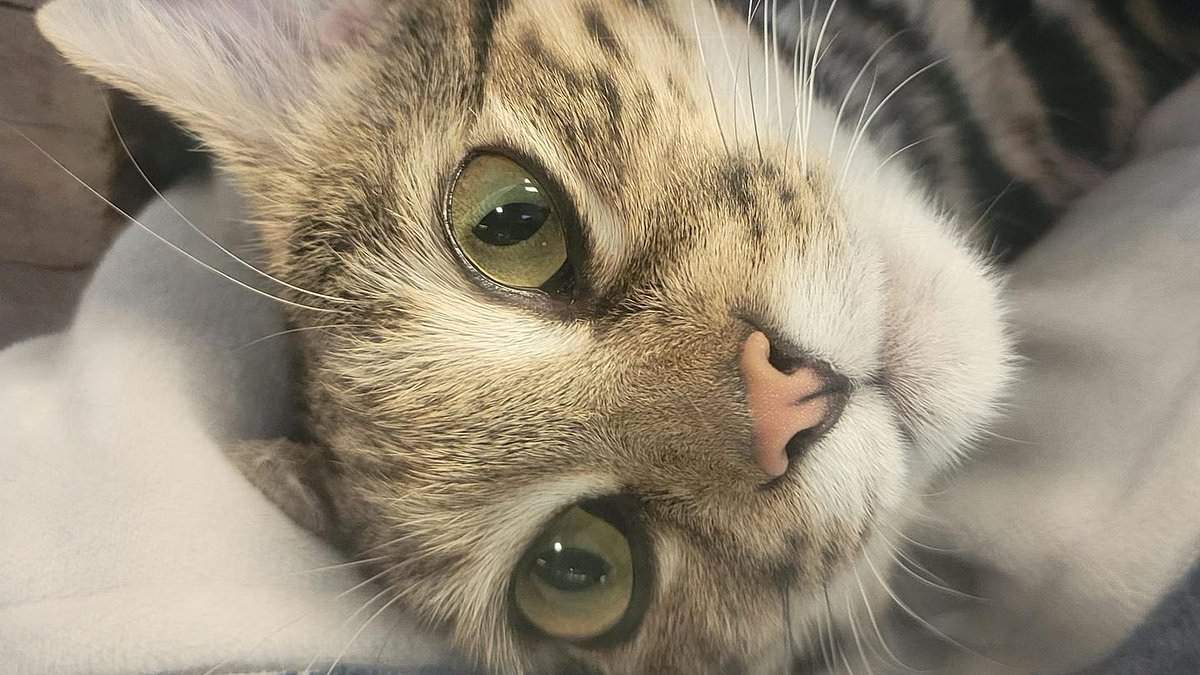Utah’s Hogle Zoo is mourning the loss of one of its black-footed cats – a four-year-old male by the name of Ryder.
Once billed as the zoo’s ‘black-footed cat bachelor,’ he died on July 22 following a brief but severe bout with kidney disease.
He had resided at the zoo since 2021, after being sent from San Diego at the advice of the Black-footed Cat Consortium, a species survival organization dedicated to the conservation of the small class of cat.
Ryder had been weeks away from meeting his would-be mate Gaia, who had been kept in an enclosure next to his since arriving in October.
Then only a few months old, she was meant to stay there until she reached sexual maturity. Teams had been in the midst of introducing the two when Ryder’s health ‘rapidly declined,’ and officials made the painful decision to put him down.

Utah ‘s Hogle Zoo is mourning the loss of one of its black-footed cats – a four-year-old male by the name of Ryder

Once billed as the zoo’s ‘black-footed cat bachelor’, he passed on July 22 following a brief but severe bout with kidney disease
‘Utah’s Hogle Zoo is mourning the loss of beloved male black-footed cat, Ryder (4), who passed away on July 22, 2024,’ their Thursday statement read.
‘After Ryder was placed under close veterinary care for advanced kidney disease, Hogle Zoo made the responsible but difficult decision to humanely euthanize him as his health rapidly declined despite treatment.
‘Ryder’s dedicated care team, including veterinarians and keepers, created an individualized treatment plan and worked together to assess his quality of life,’ the bulletin continued.
‘We discovered Ryder’s kidney disease during a health exam following notable changes in his behavior and weight.
‘Our animal health team also performed a necropsy that confirmed his advanced kidney disease.’
The statement went on to recall how Ryder – whose species is considered one the zoo’s deadliest in terms of straight statistics – to Hogle from San Diego Zoo Safari Park as a part of a breeding recommendation from the Black-footed Cat Consortium’
‘Best known for his playful yet mellow personality,’ his keepers wrote, ‘Ryder loved the challenge of puzzle feeders and had a special fondness for scratching posts sprinkled with cinnamon.’
Tammy Walling, Animal Care Supervisor of the building where both Ryder and Gaia had resided, wrote: ‘Ryder was a guest favorite in the Small Animal Building.

Ryder had been weeks away from meeting his would-be mate Gaia, who had been kept in an enclosure next to his since arriving in October

Teams had been in the midst of introducing the two when Ryder’s health ‘rapidly declined’, and officials made the painful decision to put him down
‘He loved to sleep by the glass and was often snuggled up in a spot where he could watch people.’
Gaia, meanwhile, continues her daily routine as usual, officials said – likely unaware that her companion has passed.
Officials said they will work with the Association of Zoos and Aquariums (AZA) and the Black-footed Cat Consortium for future breeding recommendations for the feline, who recently turned a year old.
‘We’ve heard your pss-pss-pss, your woes about Gaia being friend-shaped, and your desire to scratch the chin of the tiniest, deadliest cat you’ve ever seen.
‘We’re not here to squash your dreams – except maybe we are,’ staffers joked.
‘While Gaia may be the cutest, tiniest, most friend-shaped feline you’ve ever seen, never forget her deadly reputation.
‘What you CAN do is visit Gaia in the Small Animal Building, where you can feel all of your big feelings for Gaia internally and from afar,’ the post, penned just last week, continued.
‘Yours truly and happy #Caturday, #utahshoglezoo.’

The zoo posted video of his prospective mate just last week, shortly after the female had reached sexual maturity. Gaia, now one, is seen here

She continues her daily routine as usual, officials said – likely unaware that her companion has passed.

The carnivores can eat around 3,000 rodents per year in their natural habitats, and are considered one of the deadliest species of cat in the world – at least in terms of statistics
A few days earlier, zookeepers shared an equally cute clip of the spotted cat pawing at a dangling piece of wood installed in her enclosure.
‘Get it, girl,’ staffers wrote in response, before reminding onlookers he carnivores can eat around 3,000 rodents per year in their natural habitats.
Meanwhile, Ryder’s malady was secretly occurring, and his future fate remained unknown.
Officials on Thursday added how the cat ‘was a beloved member of our zoo family and an outstanding ambassador’ for his species.
‘To Ryder’s community—including his dedicated animal care and health teams, staff, volunteers, and guests—thank you for being part of Ryder’s life,’ they went on to write.
‘He will be greatly missed.’
Black-footed cats are found mostly in arid parts of Namibia, Botswana, and South Africa.
They can stalk their prey for hours on end, at times over distances pegged at around 20 miles.
But it’s the black-footed cat’s prowess when it comes in contact with the odd bird or gerbil when it really shows its prowess – flattening itself to the ground like a rug before pouncing with maximum power.
The result is a cat that can literally spring itself into the air several feet to catch an escaping bird – hence its success rate.
Considering this is out in the savannahs and deserts of some of the harshest areas of the world, this is nothing to sneeze at.
Despite all this, the black-footed cat is considered ‘vulnerable’ – just one step before endangered.
A 2016 assessment revealed that only around 9,700 of the killer cats are living in the wild in Botswana, Namibia and South Africa, with the odd one kept in exhibits like the one opened in December in Utah.
